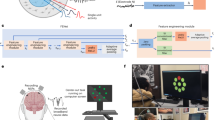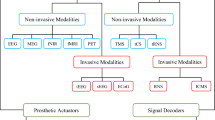Abstract
The paper proposes an approach to and solves the problem of controlling a robot by using neural interface technology, describes the general scheme and working principle of the main idea of non-invasive neural interface control of a robot using the original convolutional neural network. The authors describe the principles of an original convolutional neural network and an approach to the modern network design, present a model of a one-dimensional convolutional network based on the principles of a human inner ear. The structure of a software package is proposed. The results of a comparison of algorithms for the analysis of human brain evoked potentials used in the design of brain-computer interfaces are presented. The authors used the Fourier transform algorithm and the multidimensional synchronization index (MSI) algorithm in various modifications to perform the experiment. Analysis of the initial signal, the accumulated evoked potential, in addition to the accumulated evoked potential spectrum were proposed as variations. Linear correlation was also evaluated with analysis using a user-derived reference signal sample and various variations of wavelet filtering. In addition, model signals, which were a combination of white noise and a harmonic oscillation simulating a stable visual evoked potential, were used. The best results (error rate <10%) with an analysis time of 3 s were obtained for the MSI of the original signal, MSI with the Fourier transform. Also in this list, there is a MSI where the wavelet filtering result of coherent accumulation was used as an etalon, a linear correlation coefficient. In a MSI the evoked potential, recovered after the wavelet transform, was used as an etalon.
Access this chapter
Tax calculation will be finalised at checkout
Purchases are for personal use only
Similar content being viewed by others
References
Lebedev, M.A., Nicolelis, M.A.: Brain-machine interfaces: from basic science to neuroprostheses and neurorehabilitation. Physiol. Rev. 97(2), 767–837 (2017). https://doi.org/10.1152/physrev.00027.2016
Wolpaw, J.R., Birbaumer, N., McFarland, D.J., Pfurtscheller, G., Vaughan, T.M.: Brain-computer interfaces for communication and control. Clin Neurophysiol. 113(6), 767–791 (2002). https://doi.org/10.1016/s1388-2457(02)00057-3
Galin, R.R., Meshcheryakov, R.V.: Human-robot interaction efficiency and human-robot collaboration. In: Kravets, A.G. (ed.) Robotics: Industry 4.0 Issues & New Intelligent Control Paradigms. SSDC, vol. 272, pp. 55–63. Springer, Cham (2020). https://doi.org/10.1007/978-3-030-37841-7_5
Galin, R., Meshcheryakov, R.: Review on human–robot interaction during collaboration in a shared workspace. In: Ronzhin, A., Rigoll, G., Meshcheryakov, R. (eds.) ICR 2019. LNCS (LNAI), vol. 11659, pp. 63–74. Springer, Cham (2019). https://doi.org/10.1007/978-3-030-26118-4_7
Meshcheryakov, R.V., Iskhakov, A.Y., Evsutin, O.O.: Analysis of modern methods to ensure data integrity in cyber-physical system management protocols. Inf. Autom. 19(5), 1089–1122 (2020). https://doi.org/10.15622/ia.2020.19.5.7
Kharchenko, S., Meshcheryakov, R., Turovsky, Y., Volf, D.: Implementation of robot–human control bio-interface when highlighting visual-evoked potentials based on multivariate synchronization index. In: Ronzhin, A., Shishlakov, V. (eds.) Proceedings of 15th International Conference on Electromechanics and Robotics “Zavalishin’s Readings.” SIST, vol. 187, pp. 225–236. Springer, Singapore (2021). https://doi.org/10.1007/978-981-15-5580-0_18
Kharchenko, S., Turovsky, Y., Meshcheryakov, R., Iskhakova, A.: Restrictions of the measurement system and a patient when using visually evoked potentials. In: Proceedings of the 12th International Conference on Developments in eSystems Engineering (DeSE), pp. 15–19. IEEE, Kazan (2019). https://doi.org/10.1109/DeSE.2019.00013
Fatih, D.A.: Bio-inspired filter banks for SSVEP-based brain-computer interfaces. In: 2016 IEEE International Conference on Biomedical and Health Informatics (BHI), pp. 144–147. IEEE, Las Vegas (2016). https://doi.org/10.1109/BHI.2016.7455855
Zhu, D., Bieger, J., Molina, G., Aarts, R.M.: A Survey of stimulation methods used in SSVEP-based BCIs. Comput. Intell. Neurosci. 2010, 1–12 (2010). https://doi.org/10.1155/2010/702357
Farwell, L.A., Donchin, E.: Talking off the top of your head: towards mental prosthesis utilizing event-related brain potentials. Electroencephalogr. Clin. Neurophysiol. 70(6), 510–523 (1988). https://doi.org/10.1016/0013-4694(88)90149-6
Kwak, N.-S., Muller, K.-R., Lee, S.-W.: A convolutional neural network for steady state visual evoked potential classification under ambulatory environment. PLoS ONE 12(2), 1–20 (2017). https://doi.org/10.1371/journal.pone.0172578
Middendorf, M., McMillan, G., Calhoun, G., Jones, K.: Brain-computer interfaces based on the steady-state visual-evoked response. IEEE Trans. Rehabil. Eng. 8(2), 211–214 (2000). https://doi.org/10.1109/86.847819
Haq S., Jackson, P.J.: Multimodal emotion recognition. In: Machine Audition: Principles, Algorithms and Systems, pp. 398–423. IGI Global (2011). https://doi.org/10.4018/978-1-61520-919-4.ch017
Han, K., Yu, D., Tashev, I.: Speech emotion recognition using deep neural network and extreme learning machine. In: INTERSPEECH, Singapore, Malaysia, pp. 223–227 (2014)
Minsky, M.: The Emotion Machine: Commonsense Thinking, Artificial Intelligence, and the Future of the Human Mind. Simon and Schuster, New York (2007)
Yan, J., Chen, S., Deng, S.: A EEG-based emotion recognition model with rhythm and time characteristics. Brain Inf. 6(1), 1–8 (2019). https://doi.org/10.1186/s40708-019-0100-y
Yue, K., Wang, D.: EEG-based 3D visual fatigue evaluation using CNN. Electronics 8(11), 1208 (2019). https://doi.org/10.3390/electronics8111208
Wang, Y., Wang, Y., Cheng, C., Jung, T.: Developing stimulus presentation on mobile devices for a truly portable SSVEP-based BCI. In: 2013 35th Annual International Conference of the IEEE Engineering in Medicine and Biology Society (EMBC), Osaka, Japan, pp. 5271–5274 (2013). https://doi.org/10.1109/EMBC.2013.6610738
Volosyak, I.: SSVEP based Bremen-BCI boosting information transfer rates. J. Neural Eng. 8(3), 036020 (2011). https://doi.org/10.1088/1741-2560/8/3/036020
Resalat, S.N., Setarehdan, S.K.: An Improved SSVEP based BCI system using frequency domain feature classification. Am. J. Biomed. Eng. 3(1), 1–8 (2013). https://doi.org/10.5923/j.ajbe.20130301.01
Iskhakova, A., Alekhin, M., Bogomolov, A.: Time-frequency transforms in analysis of non-stationary quasi-periodic biomedical signal patterns for acoustic anomaly detection. Inf. Control Syst. 1, 15–23 (2020). https://doi.org/10.31799/1684-8853-2020-1-15-23
Zhang, Y., Peng, X., Cheng, K., Yao, D.: Multivariate synchronization index for frequency recognition of SSVEP-based brain–computer interface. J. Neurosci. Methods 221, 32–40 (2014). https://doi.org/10.1016/j.jneumeth.2013.07.018
Belobrodsky, V.A., Kurgalin, S.D., Turovsky, Y., Vahtin, A.A.: Developing a genetic algorithm for digital filters design to classify biomedical signals and testing the algorithm on known property signals. Biomed. Radioelectron. 2, 56–64 (2015). (In Russ.)
Turovsky, Y., Kurgalin, S.D., Vahtin, A.A., Borzunov, S.V., Belobrodsky, V.A.: Event-related brain potential investigation using the adaptive wavelet recovery method. Biophysics 60(3), 443–448 (2015). https://doi.org/10.1134/S0006350915030203
Turovsky, Y.A., Borzunov, S.V., Danilova, A.V., Glagoleva, E.P.: Dynamics of involuntary formation of EEG correlation patterns by biofeedback mechanism. Ulyanovsk Med. Biol. J. 2, 90–99 (2020). https://doi.org/10.34014/2227-1848-2020-2-90-99
Turovsky, Y.A.: Comparative characteristics of the algorithms of detection steady state visually evoked potentials of the brain on an electroencephalogram. Cifrovaya Obrabotka Signalov 1, 51–55 (2018)
Acknowledgements
The reported study was partially funded by RFBR, project number 19-29-01156.
Author information
Authors and Affiliations
Editor information
Editors and Affiliations
Rights and permissions
Copyright information
© 2022 Springer Nature Switzerland AG
About this paper
Cite this paper
Turovskiy, Y., Volf, D., Iskhakova, A., Iskhakov, A. (2022). Neuro-Computer Interface Control of Cyber-Physical Systems. In: Jordan, V., Tarasov, I., Faerman, V. (eds) High-Performance Computing Systems and Technologies in Scientific Research, Automation of Control and Production. HPCST 2021. Communications in Computer and Information Science, vol 1526. Springer, Cham. https://doi.org/10.1007/978-3-030-94141-3_27
Download citation
DOI: https://doi.org/10.1007/978-3-030-94141-3_27
Published:
Publisher Name: Springer, Cham
Print ISBN: 978-3-030-94140-6
Online ISBN: 978-3-030-94141-3
eBook Packages: Computer ScienceComputer Science (R0)




